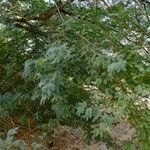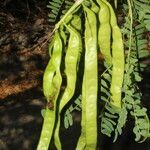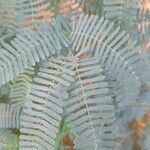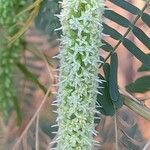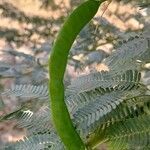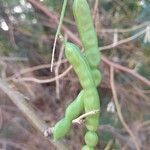Small shrub to moderate tree, the branchlets terete, glabrous, flexuous, obscurely lenticellate, usually armed at the "nodes" with prominent paired spines up to a few cm. long. Leaves arising from very condensed short-shoots, moderate or moderately large, bipinnate, the pinnae mostly 1-2 pairs, opposite, the leaflets few to many pairs per pinna; petiole prominent, most frequently 2-5 cm. long, terete but flattened above, normally bearing a small, sessile, subconic gland apically above; rachis shorter than the petiole or obsolete, glabrous, apiculate terminally from be-low; pinnae 3-10 cm. long, the rachis glandular at the distal 1 to few rachial nodes; leaflets linear to oblong, 5-20 mm. long and 1-5 mm. wide, usually rounded or obtuse apically and basally, scarcely inequilateral, dull, glabrous or subglabrous, the venation remote and moderately prominent below; stipules linear, subsetiform. Inflorescence a slender, elongate, briefly pedunculate, axillary spike inserted on the short-shoots; peduncles mostly 1-2 cm. long, often sparsely pubescent and minute-ly bracteate above the middle; spike commonly about 6 cm. long, rather densely flowered, the floral bracts minute. Flowers sessile, whitish; calyx cupular, about 1 mm. long, glabrous or pubescent, the 5 teeth narrow and remote; petals 5, sub-linear, 2-3 mm. long, free (at least in age), pilose within especially distally; stamens normally 10, up to 6 mm. long, free, glabrous; anthers ovate, less than 1 mm. long, gland-tipped (gland often caducous); ovary pubescent; style stout, exceeding the stamens. Legume linear or linear-subtorulose, not uncommonly 20 or more cm. long and 8 mm. wide or wider, flattened or turgid, pulpy, indehiscent.
More
Tree or shrub to 6 m tall; branchlets glabrous; spines solitary or paired, 5 mm long. Leaves green; main axes 5–25 mm long, glabrous or somewhat pubescent; pinnae mostly 1–3-jugate, 5.5–8 cm long; leaflets (7–) 13–21-jugate, narrowly oblong, obtuse, apiculate, herbaceous, relatively soft and thin, not lying flat when dry, somewhat curled or corrugated, (5–) 10–16 mm long, 1.5–3 mm wide, 3–6 times as long as wide, glabrous or somewhat hairy, ciliolate; internodes of pinnae axes 3–8 mm long. Racemes 7–8 cm long, c. twice as long as the leaves. Calyx with a few, scattered hairs outside, ciliolate. Pod straight or slightly curved, with parallel margins, 12–18 cm long, c. 12 mm wide, straw yellow to brown, glabrous. [This description from the Flora of Australia Volume 12 may require revision if it included specimens of Prosopis pallida that were identified as P. juliflora at the time-Editor, 26 September 2022.]
A small tree up to 15-20 m tall with long cracks in the bark. It is often a smaller tree about 3-5 m high. It is spiny and deciduous. Some kinds have thorns 5 cm long. The young branches are smooth and green. The bark is thick and rough grey-green. The leaves are twice divided. The leaflets are oblong and narrow. They are 1.5 cm long. There is no leaflet at the end. The flowers are golden yellow and crowded into dense spikes. These are 5-10 cm long and have a smell. The fruit is a yellow pod 10-20 cm long. The pod is brittle. It has brown seeds embedded in a whitish pulp. There are 10-20 seeds inside. It is a legume.
Flat-topped spiny deciduous tree or shrub to 12 m high, with rough furrowed grey or brown bark and yellowish inner bark. Flowers 4-5 mm long in crowded, cylindrical inflorescences, 5-10 (-15) cm; corolla pale yellow. Fruits pale yellowish brown, linear, straight or slightly curved, 8-29by 0.8-1.7 cm, thick but compressed. Seeds brown, ovoid, c. 6 m long, embedded in a whitish, slightly sweet pulp.
See Prosopis juliflora (Sw.) DC. var. juliflora
A tropical plant. It grows well in arid regions. It can grow on poor, sandy or rocky soil and can grow on salty soils. It grows in the Sahel. It has been introduced and is grown in some coastal areas of Papua New Guinea. It has also become self sown. It grows in areas with an annual rainfall between 150-750 mm. It grows between 600-2,400 m above sea level. It is wind resistant. It can grow in arid places.
More
Light, sandy or gravelly soils in arid or semi-arid areas where there is subterranean moisture. Commonly found on over-grazed land.
